10.5: The Changing Landscape of Oceania
- Page ID
- 131927
From the earliest migrations to European colonization, human settlement has reshaped the physical landscape of this region. Environmental degradation is a serious concern as economic growth often comes at the expense of environmental sustainability. In Australia, for example, wide stretches of previously sparsely inhabited Outback have become grazing lands. In Papua New Guinea, illegal logging has contributed to significant deforestation. Pollution from dairying in New Zealand has led to high levels of water pollution.
Invasive species have also had significant environmental impacts. Australia has strict quarantine laws in an attempt to limit damage from nonnative plants and animals. The country currently spends around $4 billion yearly in invasive weed management alone. Cats have been banned in parts of New Zealand where they pose a threat to local bird species. Rats brought by early European ships have presented a significant problem, since they kill other plants and animals, as well as spread disease. Offshore, invasive fish and algae species have damaged fragile ocean ecosystems.
In addition to local pollution concerns, global human settlement has contributed to pollution in the Pacific Ocean. There are five main ocean gyres, large systems of rotating ocean currents (Figure \(\PageIndex{1}\)). In the northern Pacific Ocean, one gyre has very high concentrations of trash and plastics carried to the area by ocean currents. It has been termed the Great Pacific garbage patch. When you throw something “away” improperly, these gyres are really where “away” is. A water bottle improperly disposed of on the western coast of North America will make its way to the Great Pacific garbage patch in around six years.

Plastics don’t biodegrade. Instead, they keep breaking down into smaller pieces while still remaining plastic. Fish and other marine life eat these tiny bits of plastic, which can disrupt a number of biological systems. Some of these fish species are then consumed by humans. Because the Great Pacific garbage patch contains such small pieces of plastic located below the surface of the ocean, it is not easily visible with the naked eye and it is difficult to estimate its size. Some scientists have theorized the patch is as big as or bigger than the US state of Texas, while others note that the idea of a “patch” of garbage is really a misnomer as there are concentrations of trash throughout the world’s oceans.
Trash from other world regions also washes up along the shores of the Pacific islands. Kamilo Beach in Hawaii is the site of a significant amount of plastic that has washed ashore from the Great Pacific garbage patch, so much so that the area has been nicknamed “Plastic Beach” (Figure \(\PageIndex{2}\)). Though the shoreline looks sandy, 90 percent of it is actually bits of plastic. In fact, you would have to dig down at least one foot to reach grains of sand. Plastic trash litter presents a hazard for marine life and a management and cleanup challenge since debris often comes from thousands of miles away.

Global climate changes pose the most severe environmental threat to Oceania. For many of the world’s regions, changes in climate are viewed as hypothetical. Hurricanes might increase in intensity. The risk of fire might increase. Changes in bird migrations in Europe and North America to shifts in global fish stocks have already been linked to increases in global temperature. In Oceania, though, small increases in temperature and ocean levels could have disastrous effects on already fragile ecosystems and economies.
The Great Barrier Reef is currently experiencing periods of coral bleaching due to increasing ocean temperatures. When waters get too warm, coral experience “stress” and expel the colorful, algae-like organisms that live within them. Mass coral bleaching has occurred several times since the late 1990s and is expected to become a regular occurrence as ocean temperatures continue to rise. Coral bleaching has also been documented in other reefs including ones in Hawaii.
Some of the leaders of the Pacific islands have been among the most vocal champions for global climate regulations. Speaking in 2015, the prime minister of Fiji, Frank Bainimarama did not mince words: “Unless the world acts decisively in the coming weeks to begin addressing the greatest challenge of our age, then the Pacific, as we know it, is doomed.” Fiji has already experienced an increase in infectious diseases related to higher temperatures, record-breaking high tides, and has had to relocate citizens due to rising ocean levels.
The effects of warming temperatures on fish have been documented in the Arctic. Scientists have recorded the melting of Arctic sea ice for the past decade (Figure \(\PageIndex{3\)). As the ice sheets melt, raising global sea levels, the surface becomes less reflective and absorbs more of the sun’s rays, further accelerating warming and beginning a cycle that could be difficult to undo. Both the North and South Poles have experienced faster warming than the rest of the world. Indeed, some areas of the Arctic have seen an increase in temperature by 3 to 4 °C (5.4 to 7.2 °F).

The rising Pacific Ocean and the concentrations of pollution are stark reminders of our interconnected world. Fossil fuel emissions from a car in the United States affect the amount of greenhouses gases in the atmosphere, which in turn can increase global temperatures and melt ice in the Arctic. A plastic shopping bag discarded improperly in Japan makes its way out to sea, where it breaks down and forms a coat of plastic sand on a Pacific island. But this same interconnectedness could perhaps be used to our advantage. Small, individual changes magnified across the global system could have profoundly positive effects. In many ways, the future of Oceania will be decided by the actions of global citizens and leaders.
- Environmental degradation:
-
the deterioration of resources like air, land, and water
- Coral bleaching:
-
occurs when coral experience “stress" due to warm waters and expel the colorful, algae-like organisms that live within them

